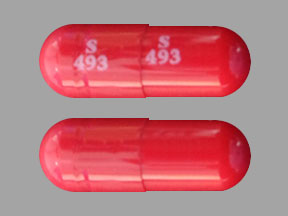S 493 S 493 Pill – Red capsule/oblong, 18mm
The red, capsule-shaped, oblong pill bearing the imprint S 493 S 493 is known to contain 100 mg of amantadine hydrochloride. Vensun Pharmaceuticals, Inc. provides it.
Uses of Amantadine
- Parkinson’s Disease: Amantadine is used to treat Parkinson’s disease symptoms include stiffness, tremors, and trouble moving.
- Influenza A: Influenza A infections can be prevented or treated with it.
Amantadine is a member of the drug families adamantane antivirals and dopaminergic antiparkinsonian agents. It is used in the treatment of extrapyramidal reactions, Parkinson’s disease, influenza, influenza A, and tardive dyskinesia. Pregnancy cannot be considered risk-free. The Prohibited Substances Act (CSA) does not classify amantadine 100 mg as a prohibited substance.
If you have seen or been administered the S 493 tablet, you are probably looking at Amantadine, a drug with a variety of applications, from treating viral infections like influenza A to aiding with specific movement problems. In this blog, we’ll go over Amantadine’s definition, mechanism of action, primary applications, potential adverse effects, and things to be aware of if you’re taking it.
| Feature | Value |
|---|---|
| Imprint | S 493 |
| Active Ingredient | Amantadine |
| Uses | Parkinson’s disease, Influenza A |
| Side Effects | Dizziness, dry mouth, insomnia, restlessness, nausea, vomiting, hallucinations, confusion, seizures, liver problems |
| Precautions | Consult a doctor before use, especially during pregnancy or breastfeeding. Inform the doctor about other medications. |
| Important Note | Always consult a healthcare professional for proper diagnosis and treatment. |
USES
Amantadine is an antiviral medication that prevents viruses from acting on your body.
Amantadine is used to treat Parkinson’s disease as well as “Parkinson-like” symptoms, which include shaking, stiffness or tremors, and uncontrollably repeated muscle movements that may be brought on by using specific medications.
Adults and children with influenza A can also be treated or prevented with amantadine. Because some virus strains may be resistant to amantadine, it might not work every flu season. It is not recommended to use this medication in place of the annual flu vaccination. To help shield you from emerging influenza virus strains every year, the Centers for Disease Control advise being vaccinated against the flu each year.
Amantadine comes in pill, capsule, and oral solution forms.
WARNINGS
If you have had a nasal flu shot within the last 14 days, do not take amantadine.
While taking amantadine and for at least 48 hours following your last dosage, avoid getting the nasal flu shot. Getting an injection of the flu vaccination while taking amantadine is possible.
Until you know how this amantadine affects you, stay away from driving and other activities that need you to be attentive or have clear vision.
If you have been sitting or lying down, get up carefully to reduce the likelihood of feeling lightheaded or fainting. Use caution when climbing and descending stairs.
Amantadine users have experienced heat stroke. When exercising or in hot temperatures, use caution.
If you experience kidney issues, consult with
Side Effects of Amantadine
Common side effects of amantadine include:
- Dizziness
- Dry mouth
- Insomnia
- Restlessness
- Nausea
- Vomiting
More serious side effects are less common but can occur, such as:
- Hallucinations
- Confusion
- Seizures
- Liver problems
Important Considerations
- Pregnancy and Breastfeeding: If you are pregnant or nursing, speak with your doctor before taking amantadine.
- Interactions: It’s important to let your doctor know about all the medications you take because amantadine may interact with other drugs.
- Dosage: Always adhere to your doctor’s recommendations about treatment duration and dosage.
- Monitoring: To evaluate amantadine’s effectiveness and keep an eye out for any negative effects, your doctor must conduct routine monitoring.
Speak with your healthcare practitioner if you have any queries or worries regarding amantadine or the S 493 pill.
Frequently Asked Questions About S 493 Pill (Amantadine)
General Questions
What is the S 493 pill?
The S 493 pill contains the medication amantadine, which is used to treat Parkinson’s disease and influenza A.
What are the common side effects of amantadine?
Common side effects include dizziness, dry mouth, insomnia, restlessness, nausea, and vomiting.
Is amantadine safe for everyone?
Amantadine may not be suitable for everyone, especially those with certain medical conditions. It’s crucial to consult with a healthcare provider before starting any new medication.
Parkinson’s Disease and Amantadine
How does amantadine help with Parkinson’s disease?
Amantadine works by increasing the levels of dopamine in the brain, a neurotransmitter that helps control movement.
For how long can amantadine be used to treat Parkinson’s disease?
The duration of amantadine treatment for Parkinson’s disease can vary depending on individual factors. It’s best to consult with a healthcare provider to determine the appropriate treatment plan.
Influenza A and Amantadine
Can amantadine prevent influenza A?
Amantadine can be used to prevent influenza A in some cases, but its effectiveness may vary.
How long does it take for amantadine to work against influenza A?
The onset of action for amantadine in treating influenza A can vary. It’s essential to follow the prescribed dosage and duration of treatment.
Remember: Always consult with a healthcare professional for personalized advice and guidance regarding the use of amantadine or any other medication.


